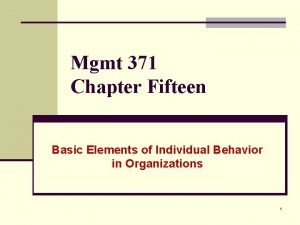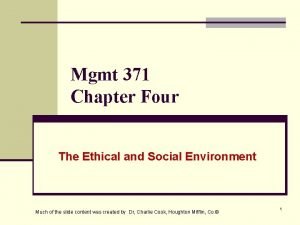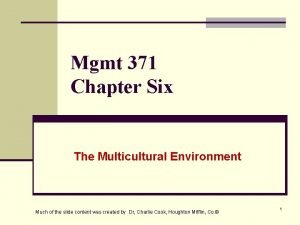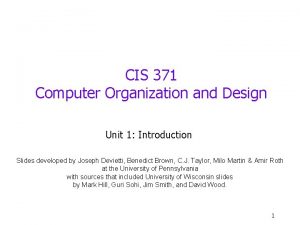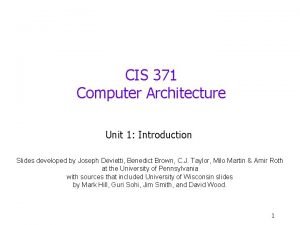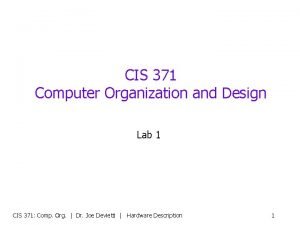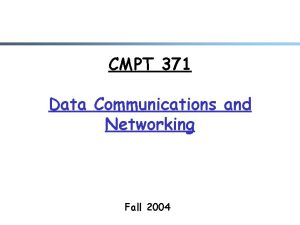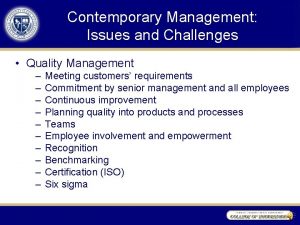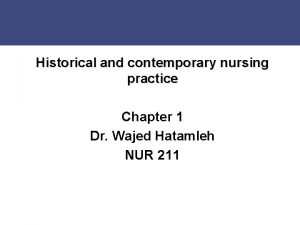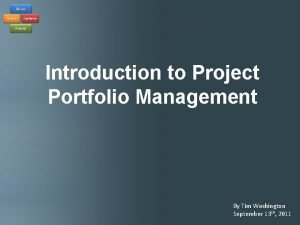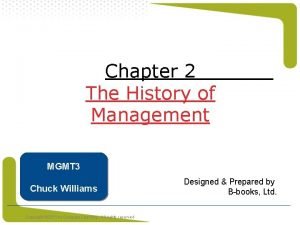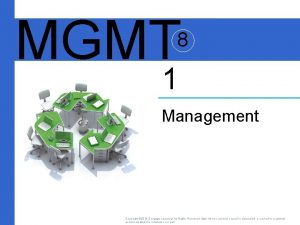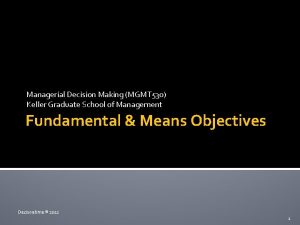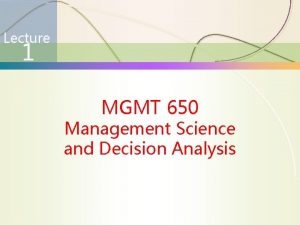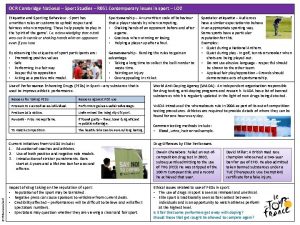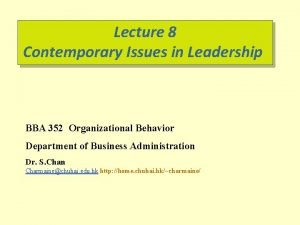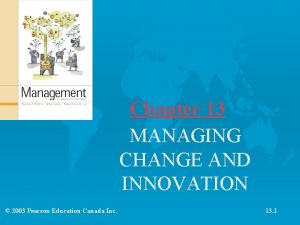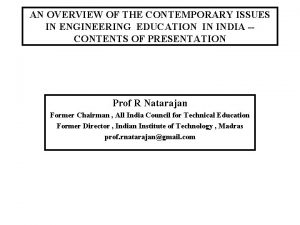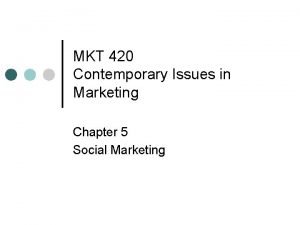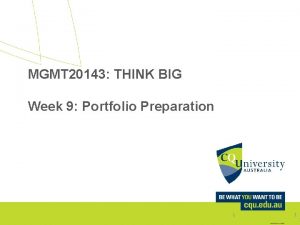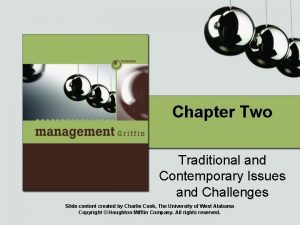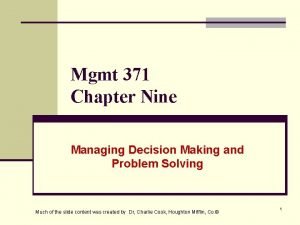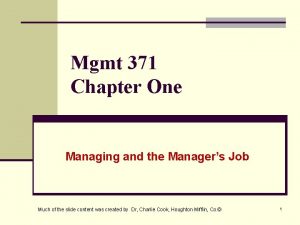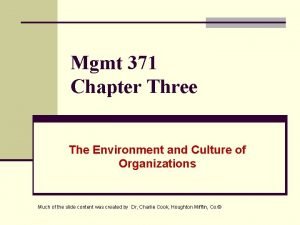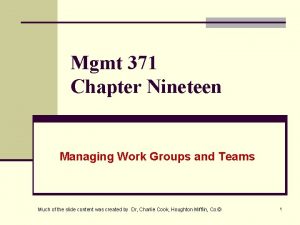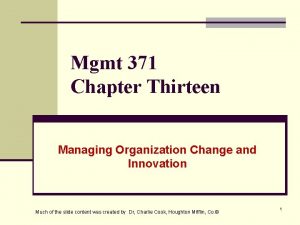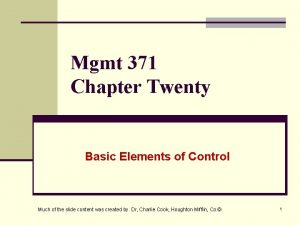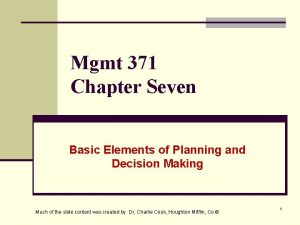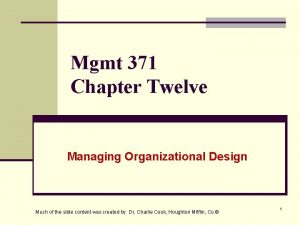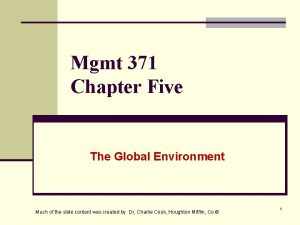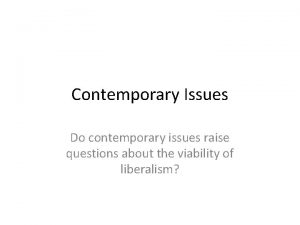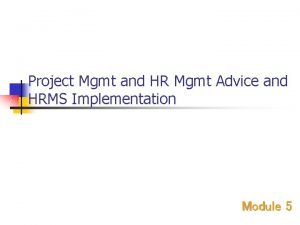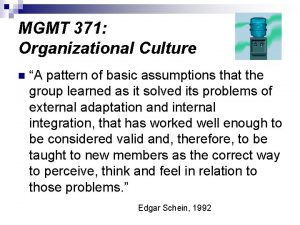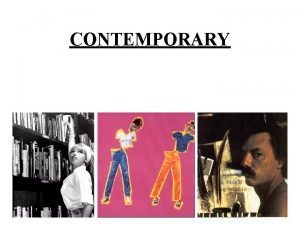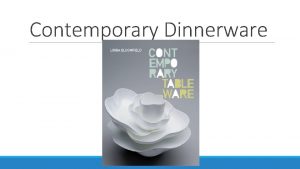Mgmt 371 Chapter Two Traditional and Contemporary Issues




































- Slides: 36

Mgmt 371 Chapter Two Traditional and Contemporary Issues and Challenges 1

The Importance of Theory and History n Why Theory? n Theory: a conceptual framework for organizing knowledge and providing a blueprint for action. n Management theories are grounded in reality. n Managers develop their own theories about how they should run their organizations. n Why History? n Understanding historical developments in management aids managers in the development of management practices and in avoiding the mistakes of others. 2

Management in Antiquity 3

Early Management Pioneers n Robert Owen (1771– 1858) n British industrialist who recognized the importance of human resources and implemented better working conditions through reduced child labor, meals, and shorter hours. n Charles Babbage (1792– 1871) n English mathematician who focused on creating efficiencies of production through the division of labor, management and labor cooperation, and application of mathematics to management problems. n Wrote “On the Economy of Machinery and Manufactures. ” 4

The Classical Management Perspective n The two major schools of the Classical Management Approach: n Scientific Management n Concerned with improving the performance of individual workers (i. e. , efficiency). Grew out of the industrial revolution’s labor shortage at the beginning of the twentieth century. Administrative Management n A theory that focuses on managing the total organization. n n 5

Scientific Management n Frederick Taylor (1856– 1915) n n “Father of Scientific Management. ” Replaced rule-of-thumb/intuitive methods with scientifically-based work methods to eliminate “soldiering” (we would call it “gaming the system” today) Believed in selecting, training, teaching, and developing workers. Used time studies, standards planning, exception rule, slide-rules, instruction cards, and piece-work pay systems to control and motivate employees. 6

Steps in Scientific Management 7

The Classical Management Perspective n Other Scientific Management Pioneers n Frank (1868 -1924) and Lillian Gilbreth (1878 -1972) n Time-motions studies [broke movements into therbligs]. n Reduced the number of movements in bricklaying, resulting in increased output of 200%. n Henry Gantt (1861 - 1919) n Was an early associate of Fredrick Taylor. n Developed other techniques, including the Gantt chart, to improve working efficiency through planning/scheduling. n Harrington Emerson (1838 -1931) n Advocated job specialization in both managerial and operating jobs. 8

The Classical Management Perspective n Administrative Management Theory n Focuses on managing the total organization rather than individuals. n Henri Fayol (1841 -1925) n Wrote “General and Industrial Management. ” n Helped to systematize the practice of management. n He was the first researcher to identify the specific management functions of planning, organizing, leading, and controlling. 9

Administrative Management Theory- Fayol’s 14 Principles n Division of work. This principle is the same as Adam Smith's 'division of labor'. Specialization increases output by making employees more efficient. n Authority. Managers must be able to give orders. Authority gives them this right. Authority should be commensurate to responsibility. n Discipline. Employees must obey and respect the rules that govern the organization. Good discipline is the result of effective leadership, a clear understanding between management and workers regarding the organization's rules. 10

Administrative Management Theory- Fayol’s 14 Principles n Unity of command. Every employee should receive orders from n n only one superior. Unity of direction. Each group of organizational activities that have the same objective should be directed by one manager using one plan. Subordination of individual interests to the general interest. The interests of any one employee or group of employees should not take precedence over the interests of the organization as a whole. Remuneration. Workers must be paid a fair wage for their services. Centralization. The degree to which subordinates are involved in decision making. Whether decision making is centralized (to management) or decentralized (to subordinates) is a question of proper proportion. The task is to find the optimum degree of centralization for each situation. 11

Administrative Management Theory- Fayol’s 14 Principles n Scalar chain. The line of authority from top management to the n n n lowest ranks represents the scalar chain. Generally, formal communications should follow this chain. Order. People and materials should be in the right place at the right time. Equity. Managers should be kind and fair to their subordinates. Stability/tenure of personnel. High employee turnover is inefficient. Management should provide orderly personnel planning and ensure that replacements are available to fill vacancies. Initiative. Employees who are allowed to originate and carry out plans will exert high levels of effort. Esprit de corps. Promoting team spirit will build harmony and unity within the organization. 12

Classical Management Proponents n Lyndall Urwick (1891 - 1983) n n Integrated the work of previous management theorists in The Elements of Business Administration. Founded ASQ in 1956. n Chester Barnard (1886 – 1961) n n Wrote “The Functions of the Executive. ” Proposed a theory of the acceptance of authority (by subordinates) as the source of power and influence for managers. 13

Classical Management Proponents n Max Weber (1864 -1920) n n n His theory of bureaucracy is based on a rational set of guidelines for structuring organizations. Die protestantische Ethik und der 'Geist' des Kapitalismus [The Protestant Ethic and the Spirit of Capitalism]. Wirtschaft und Gesellschaft [The Theory Of Social And Economic Organization]. n The “ideal bureaucracy”. 14

The Classical Management Perspective Today n Contributions n n n Laid the foundation for later theoretical developments. Identified management processes, functions, and skills. Focused attention on management as a valid subject of scientific inquiry. n Limitations n n n More appropriate approach for use in traditional, stable, simple organizations. Prescribed universal procedures that are not appropriate in some settings. Employees viewed as tools rather than as resources. 15

The Classical Management Perspective 16

The Behavioral Management Perspective n Behavioral Management n n Emphasized individual attitudes and behaviors, and group processes. Recognized the importance of behavioral processes in the workplace. n Hugo Munsterberg (1863– 1916) n A German psychologist, considered the father of industrial psychology, wrote “ Psychology and Industrial Efficiency, ” a pioneering work in the practice of applying psychological concepts to industrial settings. 17

The Hawthorne Studies n Elton Mayo (1880 -1949) n Western Electric Hawthorne, IL plant (1927– 1935): n Illumination study of changes in workplace lighting unexpectedly affected both the control group and the experimental group of production employees. n Group study—the effects of a piecework incentive plan on production workers. § Workers established informal levels of acceptable individual output; over-producing workers (“rate busters”) and under-producing workers (“chiselers”). n Interview program § Confirmed the importance of human behavior in the workplace. 18

The Behavioral Management Perspective n The Human Relations Movement n Grew out of the Hawthorne studies. n Proposed that workers respond primarily to the social context of work, including social conditioning, group norms, and interpersonal dynamics. n Assumed that the manager’s concern for workers would lead to increased worker satisfaction and improved worker performance. 19

The Behavioral Management Perspective n Human Relations Movement n Abraham Maslow (1908 -1970) n n Advanced a needs theory that employees are motivated by a hierarchy of needs that they seek to satisfy. Douglas Mc. Gregor (1906 -1964) n Proposed Theory X and Theory Y concepts of managerial beliefs about people and work. 20

Theory X and Theory Y 21

The Emergence of Organizational Behavior n A contemporary field focusing on behavioral perspectives on management. n Draws on psychology, sociology, anthropology, economics, and medicine. n Important organizational behavior topics: n Job satisfaction and job stress n Motivation and leadership n Group dynamics and organizational politics n Interpersonal conflict n The design of organizations 22

The Behavioral Management Perspective Today n Contributions Provided insights into motivation, group dynamics, and other interpersonal processes. n Focused managerial attention on these critical processes. n Challenged the view that employees are tools and furthered the belief that employees are valuable resources. n Limitations n Complexity of individuals makes behavior difficult to predict. n Many concepts not put to use because managers are reluctant to adopt them. n Contemporary research findings are not often communicated to practicing managers in an understandable form. n 23

The Behavioral Management Perspective 24

The Quantitative Management Perspective n Quantitative Management n Helped the World War II Allied forces manage logistical problems. n Focuses on decision making, economic effectiveness, mathematical models, and the use of computers to solve quantitative problems. n Management Science n Focuses on the development of representative mathematical models to assist with decisions. n Operations Management n The practical application of management science to efficiently manage the production and distribution of products and services. 25

The Quantitative Management Perspective Today n Contributions n n n Developed sophisticated quantitative techniques to assist in decision making. Application of models has increased our awareness and understanding of complex processes and situations. Has been useful in the planning and controlling processes. n Limitations n n n Quantitative management cannot fully explain or predict the behavior of people in organizations. Mathematical sophistication may come at the expense of other managerial skills. Quantitative models may require unrealistic or unfounded assumptions, limiting their general applicability. 26

The Quantitative Management Perspective 27

Integrating Perspectives for Managers n Systems Perspective - Ludwig von Bertalanffy (1901 -1972) n n A system is an interrelated set of elements functioning as a whole. Open system n An organization that interacts with its external environment. Closed system n An organization that does not interact with its environment. Subsystems n The importance of subsystems is due to their interdependence on each other within the organization. 28

The Systems Perspective of Organizations 29

Systems Perspective n Synergy n Subsystems are more successful working together in a cooperative and coordinated fashion than working alone. n The whole system (subsystems working together as one system) is more productive and efficient than the sum of its parts. n Entropy n A normal process in which an organizational system declines due to failing to adjust to change in its environment n Entropy can be avoided and the organization reenergized through organizational change and renewal. 30

The Contingency Perspective n Universal Perspectives n Include the classical, behavioral, and quantitative approaches. n Each attempted to identify the “one best way” to manage organizations. n The Contingency Perspective n Suggests that each organization is unique. n The appropriate managerial behavior for managing an organization depends (is contingent) on the current situation in the organization. 31

The Contingency Perspective n An Integrative Framework n Is a complementary way of thinking about theories of management. n Involves the recognition of current system and subsystem interdependencies, environmental influences, and the situational nature of management. 32

An Integrative Framework of Management Perspectives 33

The Emergence of Modern Management Perspectives 34

Contemporary Applied Management Perspectives n William Ouchi’s (1943) “Theory Z, ” n Peters and Waterman’s “In Search of Excellence” n Edward and Lawler Lyman Porter integrative model. n Stephen Covey, “The 7 Habits of Highly Effective Managers. ” 35

Contemporary Management Issues and Challenges n Contemporary Management Challenges n n n n n An erratic economy that limits growth Management of an increasingly diverse workforce Employee privacy Technology that promotes telecommuting The role of the Internet in business strategy Operating and competing in diverse global markets Ethics in corporate governance and social responsibility Quality as the basis for competition The shift toward a service economy 36
 Mgmt 371
Mgmt 371 Mgmt 371
Mgmt 371 Mgmt 371 final exam
Mgmt 371 final exam Cis 371
Cis 371 Intel 4004 transistor count
Intel 4004 transistor count 714 onluğa yuvarlama
714 onluğa yuvarlama Cis371
Cis371 284 371 in word form
284 371 in word form Cmpt 371
Cmpt 371 6 371
6 371 Top dop
Top dop What are contemporary management issues
What are contemporary management issues Contemporary issues in tourism
Contemporary issues in tourism Define nursing
Define nursing Infrastructure mgmt
Infrastructure mgmt Ppmexecution
Ppmexecution Chapter 2 history of management
Chapter 2 history of management Tfanet
Tfanet Mgmt+8
Mgmt+8 Keller graduate school of mgmt
Keller graduate school of mgmt Mgmt 341
Mgmt 341 Mgmt 650 quiz 4
Mgmt 650 quiz 4 Locational break even analysis
Locational break even analysis Mgmt ama
Mgmt ama Mgmt ama
Mgmt ama Mgmt 411 purdue
Mgmt 411 purdue Contemporary health issues
Contemporary health issues Ppt index
Ppt index R051 contemporary issues in sport
R051 contemporary issues in sport How do charismatic leaders influence followers
How do charismatic leaders influence followers Contemporary issues in marketing
Contemporary issues in marketing Contemporary issues in hrm
Contemporary issues in hrm Contemporary economic issues in the philippines
Contemporary economic issues in the philippines Contemporary issues in managing change
Contemporary issues in managing change Contemporary issues in engineering
Contemporary issues in engineering Marine insurance contemporary issues
Marine insurance contemporary issues 420 marketing campaigns
420 marketing campaigns
